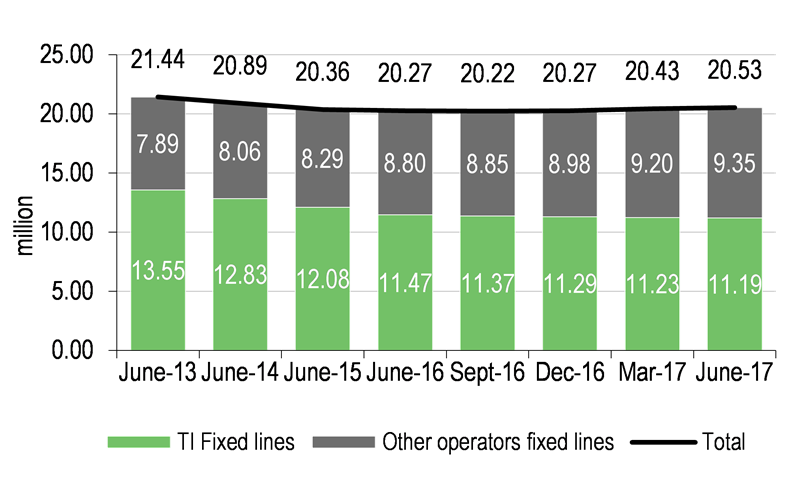Target market and commercial offer
With only 63% broadband penetration in Italy, there remains headroom for growth for all operators in GO’s regions. However, unlike ADSL rivals, GO’s wireless service does not require customers to also take a fixed telephone line. Consequently, GO’s natural market to date has been the increasing number of ‘mobile-only’ homes in Italy that have opted to relinquish the Telecom Italia fixed-line phone connection, which is increasingly seen as redundant as mobile services have become more widespread (Exhibit 7).
In order to stem the declines in fixed-line subscribers, TI has reduced prices and over the last years, ‘cord cutting’ appears to have stabilised. Nevertheless, together with the c 100k homes that have no ADSL access (so called ‘digital divide homes’), there are approximately one million homes in GO’s licensed regions that for one reason or another have no fixed line connection.
GO’s brand is known for its competitive pricing, convenience and speed:
Competitively priced: without the need for a fixed-line rental, coupled with GO’s light central cost base (c 50 employees), it is able to offer competitive prices. Even taking account of special offers, GO’s services remain amongst the cheapest on the market.
High speed: the basic service runs at a maximum speed of 12Mbps with an average speed comparable with ADSL services in Italy. The 100Mbps service gives an average speed of 30Mbps, making it faster than many ADSL services, and GO will soon start to market its fibre services with speeds of 1Gbps (ie 1,000Mbps), enabling it to compete across the spectrum of service levels.
Convenience: the small and lightweight indoor CPEs, which account for the majority (c 85%) of subscribers, provide a no-hassle plug & play installation. This compares to ADSL customers, who often need to wait a few days for activation and may also require installation by an engineer.
Mobility: the plug & play modem can be used anywhere in the coverage region; for instance, customers can take it to second homes for the weekend.
Strategy: Extend network, leverage brand in fibre
The introduction of more powerful base stations is a key pillar in management’s strategy to increase coverage in its two regions and to remain competitive. Management targets the installation of c 10-15 base stations a month. Each base station can support approximately 50-60 subscribers, and the attachment rate has been fairly consistent (Exhibits 9 and 10). The lack of clarity over funding during 2016 (refer to our report Rights issue for accelerated network roll-out for more detail) meant that GO had to slow the pace at which it rolled out its network to conserve liquidity. The October 2016 rights issue, which raised an additional €4m, enabled the pace of network expansion to subsequently pick up. However, with the network nearly at capacity, and increasing churn from the WiMAX subscriber base, it has resulted in a knock-on effect on the rate at which it has signed subscribers.
Pricing is being used to encourage new subscribers to opt for the faster service (where the group has more capacity). Management periodically splits out subscriber growth by technology and this policy is clearly working, with all the new subscribers in recent months coming from its higher bandwidth services, and the majority of cancellations from the WiMAX services. Provided churn for the LTE services remains low, this should also result in an increasing ARPU as more customers enter the second year of their contracts on higher prices. GO is pre-emptively contacting subscribers reaching the end of their contract period to encourage a high rate of retention.
The installation of a 5G network overlaying its current WiMAX network would both improve the capacity of its network (these base stations should be able to carry c 100 subscribers each), as well as improving the service level considerably, offering ‘fibre-like’ speeds.
In July 2016 GO announced that it had partnered with EOF in Perugia (Umbria) to market its ultra-wideband, FTTH network. Since launching in June 2017, the group has made approximately 50 fibre subscriber additions each month and has now announced its intention to extend the offer to 23 cities.
While the initial results in Perugia are respectable (c 0.7% market share within six months) GO’s brand is less well known in Umbria. The additional cities being targeted will be in GO’s existing wireless regions, where its brand is well established. This will enable it to keep the cost of marketing to a minimum, and leverage existing retail relationships.
The 23 cities represent approximately 900k homes and GO’s marketing will track the fibre roll-out plan of EOF, which we understand targets full coverage by the end of 2018 in these areas.
Exhibit 9: Progression base station roll-out and subscriber growth
|
Exhibit 10: Subscribers per base station
|

|

|
Source: Edison Investment Research, GO internet
|
Source: Edison Investment Research, GO internet
|
Exhibit 9: Progression base station roll-out and subscriber growth
|

|
Source: Edison Investment Research, GO internet
|
Exhibit 10: Subscribers per base station
|

|
Source: Edison Investment Research, GO internet
|


















